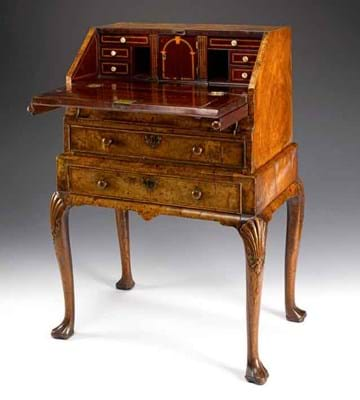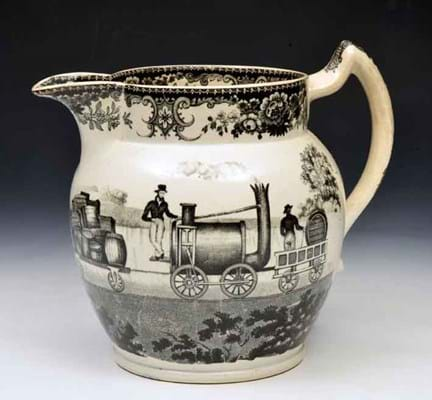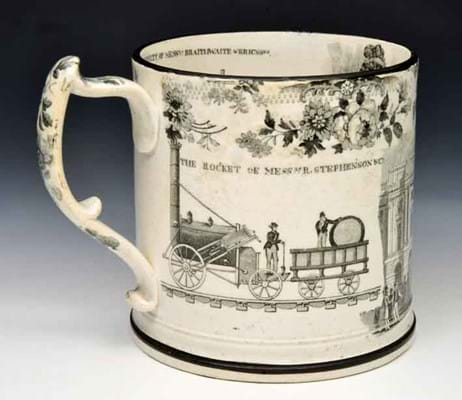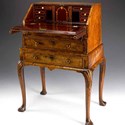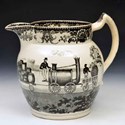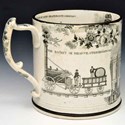The collector in question was Captain Hugh Vivian, identified by the survival of a number of carefully preserved receipts, and his furniture combined quality with the type of longstanding provenance that does much to reassure bidders.
Outstanding in this regard was a small George II walnut bureau on stand which led the sale on February 26 with a bid of £30,000 from an overseas telephone bidder.
This was an early form, with a clear break between the slope-fronted writing desk and cabriole-legged stand which had stylised shell carvings at the knees and trefoil feet.
There were some signs of wear and tear, with small areas of veneer missing, but it had an attractive overall patina and would have been regarded as a top-drawer survivor from the golden age of English walnut when it was purchased by Captain Vivian at Malletts of Bond Street in October 1943.
The receipt from the famous London firm affirmed that it was a piece from the Percival D. Griffiths Collection, while a later hand noted that the desk was illustrated in R.W. Symonds' seminal 1929 work English Furniture Charles II to George II. The Griffiths Collection, formed under the guidance of Symonds, had been dispersed by Christie's in May 1939 and, despite the highly eventful three and a half years in between, its formidable reputation must have been fresh in the memory when Captain Vivian paid the considerable sum of £525 for the desk.
Inflation calculators suggest that this would have been equivalent to over £20,000, today, and an estimate of £30,000-50,000 indicates there were hopes that the desk might go on to even higher levels at the Mallams sale.
At Christie's in 2006 another bureau on stand from the Griffiths Collection, of very similar design but fitted as a dressing chest with a large cheval glass above, sold to a UK collector for £156,000, but the market has undoubtedly softened since then.
Railwayana
Walnut furniture was not Captain Vivian's only interest and his collection of early railway commemoratives proved equally well documented, with receipts from various dealers dating from the 1930s and '40s. The Mallams sale included around 20 lots which were firmly focussed on the opening of the Liverpool and Manchester Railway in 1830 and the Rainhill Trials which were run the previous year to find the most suitable locomotive for the line.
The Rainhill competition was famously won by Stephenson's Rocket, the only locomotive to complete the trias, and this features on many of the commemoratives, as does the Northumbrian, a successor to the Rocket which led the parade at the opening of the railway.
A black and white frog mug, 5in (13cm) high, with some damage, printed with a view of the Exchange Building and Nelson's Monument in Liverpool flanked by two views of the Northumbrian, sold for £420, while another with titled vignettes of Rocket and Northumbrian, reached £950.
On the inside, both mugs were decorated with carriages and Braithwaite and Ericsson's Novelty, another engine that had competed at Rainhill. A similar mug (they are thought to have been made at the short-lived Herculaneum factory in Liverpool) sold for £1400 at Peter Wilson in Nantwich in November 2008.
The successor to the Novelty, Braithwaite & Ericson's William IV, was depicted pulling coaches full of passengers on a black printed jug and matching mug, 4½in (11cm) and 4in (10cm) high, which sold together for £750.
The engines were the technological wonders of the age, but trains cannot run without a track and commemorative wares also made much of the tunnel entrance to the Liverpool & Manchester line.
A single Staffordshire black-printed mug, 3¼in (8cm) high, showing engines passing at the entrance, made £220, while a lot of three jugs depicting the same scene, the largest 5½in (14cm) high, made £420. Slightly upmarket, a pair of square-section porcelain vases, 5¼in (13cm) high, decorated with various coloured landscape scenes, but crucially featuring the entrance to the Liverpool and Manchester tunnel in one of the lower reserves, made £680.
Sans Pareil
Many of these early commemorative wares feature named views and identified engines, but the strongest competition in this section was for a 6¼in (16cm) high black-printed jug decorated around the outside with an unnamed engine pulling four wagons variously loaded with passengers, barrels and animals.
It would be easy to assume that this was simply a generic portrait of an early locomotive, but comparison with engravings of the period suggests that it is an accurate depiction of Timothy Hackworth's Sans Pareil, which was one of the more basic engines to take part in the Rainhill Trials.
The Sans Pareil is recognised by its distinctive 'fool's cap' funnel top and the vertical cylinders which caused it to waddle from side to side as it progressed. When it arrived for the trials it was found to be overweight but competed well until a cylinder cracked. This caused some controversy, since the casting had been done at the Stephenson factory. The Sans Pareil was later repaired, bought by the L&MR and gave many years of service on this and other lines.
It may have under-achieved in 1829, but in the saleroom the Sans Pareil out-performed all the other engines when the jug sold for £2000.
Such was the excitement caused by the appearance of these smoke-belching leviathans in the 1830s, it is easy to forget that much of the rail transport at the time, was actually pulled by horses.
Three pieces of leather harness, each decorated with three brasses, added an extra dimension to the railwayana collection.
It is some time since standard horse brasses were a force to be reckoned with in the saleroom, but a few early steam engines among more traditional decorative motifs meant that these made £380 where £20-30 was estimated.
The buyer's premium was 20%.


